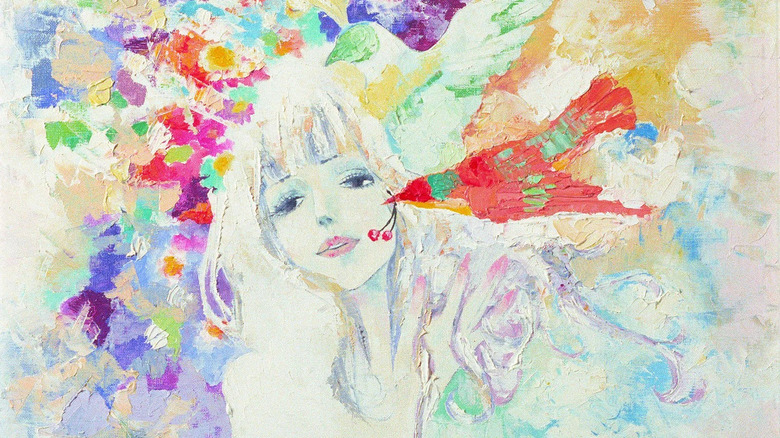This Stunning Yet Controversial '70s Animated Movie Flopped So Hard That It Bankrupted Its Studio
Something uncanny was in the air in the late 1960s and early '70s. A lively curiosity in witchcraft, paganism, and occultism, rose out of the counterculture movement, finding its way into popular entertainment in the form of folk horror and other similarly-themed movies. Perhaps the most notorious was "The Devils," Ken Russell's orgy of unbridled lust and religious mania set in medieval France. Also treading along a scandalous path was Elichi Yamamoto's stunning "Belladonna of Sadness," a controversial adult animated feature that broke its studio.
This psychedelic arthouse trip was the third and most challenging of the "Animerama" films from Mushi Production in Japan. It was a radical departure for writer and director Yamamoto, who built his career in the '60s making cuddly children's TV shows like "Astro Boy" and "Kimba the White Lion." He was a key figure in early anime, but "Belladonna" has a distinctly European flavor; inspired by "La Sorcière," Jules Michelet's study of witchcraft in the middle ages, it tells the story of a young French woman who is subjected to sexual violence by local nobility before striking a deal with the Devil and becoming a powerful witch.
The film was a labor of love for Yamamoto; working with artist Kuni Fukai, the painstakingly illustrated film took six years to complete. Sadly, they pushed the experimental style too far and it failed to find an audience at the box office, sealing the fate of Mushi Production. The studio shuttered its doors within a year of "Belladonna" hitting theaters. The mystique as a hard-to-find cult item only grew over the decades before it received a belated stateside release in 2016, where it was greeted as an intensely polarizing curio and one of the saddest anime movies ever made.
Belladonna of Sadness is slight on plot but rich in visuals
"Belladonna of Sadness" begins on a dreamy note as our protagonist Jeanne ties the knot with her hunky new husband Jean. Unfortunately, their marital bliss is short-lived as they are summoned to the baron's court; there, she is sexually assaulted by the nobleman and his cohorts. In her distress, Jeanne is visited by a very phallic demon sprite, who offers her power and riches in exchange for carnal favors.
Jeanne accepts the trade and uses the Devil's magic to build her and her husband's status in the community, threatening the baron's domination over the downtrodden serfs. Affronted by her growing influence, he sends his men to capture her, but she flees to the forest where she fully surrenders her body and soul to Satan. Rebelling against her tormentors, she then uses her formidable powers to save the villagers from the Black Death and liberates them with a wild orgy. Anyone with a basic knowledge of how witches were treated in medieval times won't be surprised by the outcome, but Yamamoto concludes with a triumphant note as Jeanne's martyrdom inspires women through the ages.
The plot is pretty thin but "Belladonna of Sadness" makes up for it with its ravishing visuals. Fusing traditional Japanese storytelling techniques, Art Nouveau splendor, and counterculture psychedelia, the film is at once breathtakingly gorgeous and also rather challenging to watch. For the most part, it's barely animated at all, with the camera scrolling and zooming across still water color images. This approach makes it all the more startling when it does finally burst into motion, dazzling the senses with some outrageously avant-garde sequences set to funky early '70s jazz-rock excursions.
Belladonna of Sadness polarizes viewers to this day
When "Belladonna of Sadness" became more readily available in the West after its 2016 release, the film divided critics and viewers alike. Some considered it grossly misogynistic and exploitative, particularly regarding how sexual assault and Jeanne herself are portrayed. On the flip side, many feminist writers have championed its condemnation of misogyny and the male gaze, its revolutionary themes, and its empowering message of sexual liberation for women.
Exploitation in media is often subjective, and the film's aggressive style challenges the viewer to examine their own reaction to its sexual violence. While Jeanne is eroticized in the way she is illustrated, there is nothing titillating about how the expressionistic animation focuses on her internal pain and anguish rather than simply observing the act of sexual assault. Jeanne's beauty is also weaponized against the attackers. Once she has consummated her deal with the Devil and shed her clothes, she takes full ownership of her nakedness, and her sexuality becomes her super power against her priggish but depraved enemies.
"Belladonna of Sadness" comes down hard on the side of the Devil as a rebellious force against the grim hypocrisy and deviancy of the baron's court; much like in Robert Eggers' "The Witch," Jeanne's Satanic pact is portrayed as a way of liberating herself from the shackles of a harsh and abusive patriarchal society. The vast majority of real-life witch-hunting victims in the Middle Ages were women, and feminist activists in more recent times have reclaimed witchcraft as an act of political defiance. There are certainly elements of that here, and Yamamoto even tacks on a coda celebrating women's influence in the French Revolution. No doubt, this must-see horror anime movie will continue to inspire lively debate as its controversial reputation grows.


